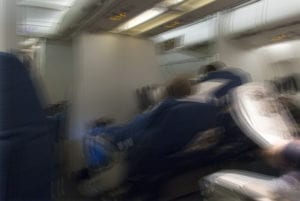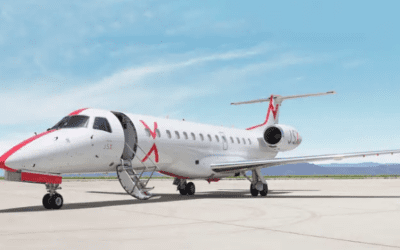The time is overdue to end the FAA lap child exception for children under two years of age.

In mid-December, Hawaiian Airlines Flight 35, from Phoenix to Honolulu, encountered severe turbulence that left 36 people hurt, with eleven suffering serious injuries. A total of twenty were taken to local hospitals in Honolulu.
Earlier this month, Condor Flight 2314 from Frankfurt, Germany, to Mauritius Island encountered severe turbulence. Twenty passengers and crew members were injured and treated by medical personnel.
Also this month, Lufthansa Flight 469 from Austin, Texas, to Frankfurt, Germany, experienced severe turbulence and was diverted to Washington Dulles International Airport. It landed safely and seven people on the Airbus A330 were taken to area hospitals. While none of the injuries to the seven were considered severe, they were serious enough to need a hospital emergency room for treatment.
Three recent flights with serious injuries during severe turbulence have emphasized the need to end the lap child exception.

Speaking for the largest flight attendant union in the US, the Association of Flight Attendants – CWA, Sara Nelson, the Union’s international president, said,
“We’ve seen airplanes go through turbulence recently and drop 4,000 feet in a split second. The G-forces are not something even the most loving mother or father can guard against and hold their child. It’s just physically impossible.”
Sara Nelson, president of the largest flight attendant union, is right. No parent can successfully hold their child during severe turbulence.
Sara Nelson is correct. You never know the exact instant when a severe turbulence jolt will occur and exert as much force as 2½ Gs, two-and-a-half times the gravity we feel when on Earth. No parent is capable of holding a child under that circumstance.
Air turbulence experienced by aircraft in the form of erratic changes in altitude and/or attitude of the plane is air movement created by various atmospheric conditions. It can occur while flying through or above storms or even on totally clear days or nights. Air turbulence often occurs without warning.
While most air travelers, even those who seldom fly, have endured some stretches of flight turbulence, they generally only experience some bumpiness, shaking, and perhaps a queasy feeling, during which the plane’s captain turns on the seatbelt sign. Few experience severe turbulence when a plane can quickly drop 100 feet or more. Even when the drop is a few feet, it’s so sudden and unexpected that it can feel like a thousand feet, mainly because the G-forces felt are significant, causing passengers and crew to be thrown upward. Unsecured belongings fly about, becoming serious hazards to everyone in the aircraft cabin.
Proponents of maintaining the FAA lap child status quo are quoting misleading statistics to justify their point of view.
Some proponents of maintaining the FAA’s lap child status quo are quoting misleading statistics and facts to justify their position. I understand parents wanting to save money when flying with their baby or infant, but the reality is that unless they purchase a seat for their children, they’re gambling with their children’s well-being.
For example, it’s true that the last time a child was killed on a US scheduled commercial airline flight due to turbulence was in 1994. That statistic omits that, overwhelmingly, almost all air travelers are adults, not children, and that we must consider passenger injuries when flying through severe turbulence, not just deaths.
It’s also true about 150 children die annually by drowning at home due to baths, etc., compared to just that one child’s death due to severe turbulence since 1994. Like the misleading stat above, this one doesn’t consider that the number of babies and infants who fly annually is a tiny fraction of the number of babies and infants taking baths at home or in other water in which they can drown. The drowning comparison also doesn’t consider children flying who may be seriously injured during severe turbulence, but survive.
Looking at passenger mortality and ignoring passenger injury caused by severe turbulence misleads parents about the safety of their children if flown as lap children.
Fortunately, from 2009 through 2021, only 30 passengers have been seriously injured, as defined by the FAA, from severe turbulence on scheduled commercial US airline flights. Statistically, very few passengers have been badly hurt from severe turbulence, but even that is misleading when we’re trying to decide whether or not babies and infants should be required to be in their own seat, in appropriate child safety seats, like those small children who are age two and above.
In fact, relying on mortality statistics alone, without considering injury from severe turbulence, makes no sense.
According to the FAA, from 2009 to 2021, 30 passengers and 116 crew members sustained serious injuries from severe turbulence. Of the 146 injuries 79.5 percent were crew members, the people on the plane that were virtually assured were standing, not seated and belted, when the turbulence hit. That critical statistic infers that when you’re seated in your own seat and belted in, it’s highly likely that you won’t be injured during periods of severe turbulence.
I’ve been on three flights with severe turbulence and was bloodied on one and saw an infant fly out of a mother’s hands, fortunately saved by another passenger who caught her.
I’ve been on three flights with severe turbulence since I first flew on a scheduled commercial flight in 1955. I was seated and belted during each incident, but I was bloodied in one incident about 16 years ago. A flying laptop computer hit me. Three butterflies were required to close the gash. I saw a doctor after we landed and got several stitches, but I’m not a severe turbulence statistic because I wasn’t hurt badly enough to be listed by the FAA.
Many air travelers have been hurt severely like me, but these aren’t statistics because the FAA requirement to be considered seriously injured is too high a threshold.
On that same flight, there was a lap infant on board. Fortunately, when she flew out of her mother’s hands, she just missed the ceiling and the man in the seat behind her caught the girl and perhaps saved her life. The plane experienced severe turbulence for about 20 seconds, though it felt like hours. Only a great deal of luck saved that infant from severe injury.
The NTSB is calling for the end of the FAA’s lap child exception.
In its 2021 report, “Preventing Turbulence-Related Injuries in Air Carrier Operations,” the National Transportation Safety Board (NTSB) states,
“There is widespread consensus among the transportation safety and medical communities, including the American Academy of Pediatrics, the Aerospace Medical Association, and the Centers for Disease Control and Prevention, that it is safest for children less than 2 years old to be seated in their own seat on an airplane, using an appropriate child restraint system (CRS), such as a car seat that is also approved for airplane use.”
I’ve seen it for myself. It’s impossible for a parent to successfully hold a child under two in their lap during severe air turbulence while inflight on an airplane, attempting to prevent its injury. The FAA should immediately end its lap child exception to its child seating rule. It’s long overdue that every small child flying should be required to be in their own seat, in an appropriate child restraint system, whenever seated.

READ ALSO:
Travelers United — Our main projects for travelers in DC
When airline computer systems fail, what do passengers get?
After many years working in corporate America as a chemical engineer, executive and eventually CFO of a multinational manufacturer, Ned founded a tech consulting company and later restarted NSL Photography, his photography business. Before entering the corporate world, Ned worked as a Public Health Engineer for the Philadelphia Department of Public Health. As a well known corporate, travel and wildlife photographer, Ned travels the world writing about travel and photography, as well as running photography workshops, seminars and photowalks. Visit Ned’s Photography Blog and Galleries.



